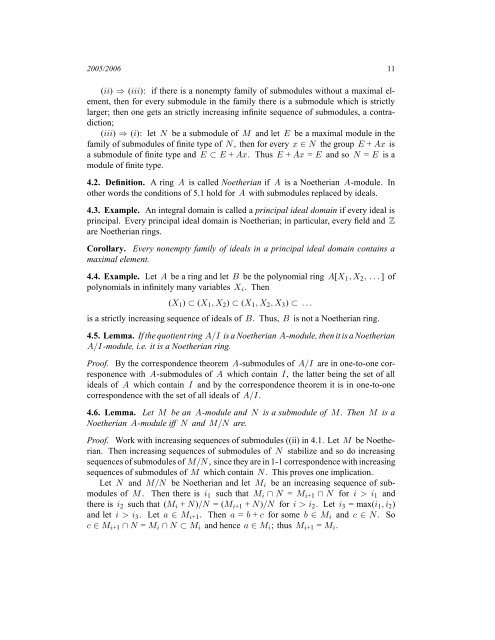Algebra (Unknown 27). - Index of
Algebra (Unknown 27). - Index of
Algebra (Unknown 27). - Index of
You also want an ePaper? Increase the reach of your titles
YUMPU automatically turns print PDFs into web optimized ePapers that Google loves.
2005/2006 11<br />
(ii) ⇒ (iii): if there is a nonempty family <strong>of</strong> submodules without a maximal element,<br />
then for every submodule in the family there is a submodule which is strictly<br />
larger; then one gets an strictly increasing infinite sequence <strong>of</strong> submodules, a contradiction;<br />
(iii) ⇒ (i): let N be a submodule <strong>of</strong> M and let E be a maximal module in the<br />
family <strong>of</strong> submodules <strong>of</strong> finite type <strong>of</strong> N , then for every x ∈ N the group E + Ax is<br />
a submodule <strong>of</strong> finite type and E ⊂ E + Ax. Thus E + Ax = E and so N = E is a<br />
module <strong>of</strong> finite type.<br />
4.2. Definition. A ring A is called Noetherian if A is a Noetherian A-module. In<br />
other words the conditions <strong>of</strong> 5.1 hold for A with submodules replaced by ideals.<br />
4.3. Example. An integral domain is called a principal ideal domain if every ideal is<br />
principal. Every principal ideal domain is Noetherian; in particular, every field and Z<br />
are Noetherian rings.<br />
Corollary. Every nonempty family <strong>of</strong> ideals in a principal ideal domain contains a<br />
maximal element.<br />
4.4. Example. Let A be a ring and let B be the polynomial ring A[X 1 , X 2 , . . . ] <strong>of</strong><br />
polynomials in infinitely many variables X i . Then<br />
(X 1 ) ⊂ (X 1 , X 2 ) ⊂ (X 1 , X 2 , X 3 ) ⊂ . . .<br />
is a strictly increasing sequence <strong>of</strong> ideals <strong>of</strong> B. Thus, B is not a Noetherian ring.<br />
4.5. Lemma. If the quotient ring A/I is a Noetherian A-module, then it is a Noetherian<br />
A/I -module, i.e. it is a Noetherian ring.<br />
Pro<strong>of</strong>. By the correspondence theorem A-submodules <strong>of</strong> A/I are in one-to-one corresponence<br />
with A-submodules <strong>of</strong> A which contain I, the latter being the set <strong>of</strong> all<br />
ideals <strong>of</strong> A which contain I and by the correspondence theorem it is in one-to-one<br />
correspondence with the set <strong>of</strong> all ideals <strong>of</strong> A/I.<br />
4.6. Lemma. Let M be an A-module and N is a submodule <strong>of</strong> M . Then M is a<br />
Noetherian A-module iff N and M/N are.<br />
Pro<strong>of</strong>. Work with increasing sequences <strong>of</strong> submodules ((ii) in 4.1. Let M be Noetherian.<br />
Then increasing sequences <strong>of</strong> submodules <strong>of</strong> N stabilize and so do increasing<br />
sequences <strong>of</strong> submodules <strong>of</strong> M/N , since they are in 1-1 correspondence with increasing<br />
sequences <strong>of</strong> submodules <strong>of</strong> M which contain N . This proves one implication.<br />
Let N and M/N be Noetherian and let M i be an increasing sequence <strong>of</strong> submodules<br />
<strong>of</strong> M . Then there is i 1 such that M i ∩ N = M i+1 ∩ N for i > i 1 and<br />
there is i 2 such that (M i + N)/N = (M i+1 + N)/N for i > i 2 . Let i 3 = max(i 1 , i 2 )<br />
and let i > i 3 . Let a ∈ M i+1 . Then a = b + c for some b ∈ M i and c ∈ N . So<br />
c ∈ M i+1 ∩ N = M i ∩ N ⊂ M i and hence a ∈ M i ; thus M i+1 = M i .

















